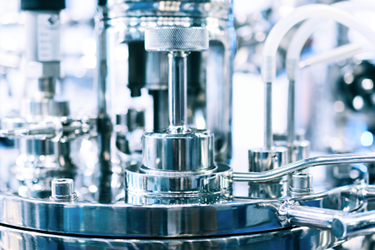Assessing The Impact Of New Equipment On Your CDMO's GMP Operations
By Greg Weilersbacher, Eastlake Quality Consulting

Everyone is fascinated by new equipment, and the excitement is not limited to engineers and manufacturing technicians. To a contract development and manufacturing organization (CDMO), new equipment often translates to additional service offerings and higher-volume productions the company can use for fresh marketing content to attract new clients and return business from existing customers. To the sponsor, the CDMO’s new equipment could mean their next production may be able to start sooner than expected, or it might allow them to continue working with their existing CDMO rather looking to the competition for the technology their product needs.
While most industry professionals understand in concept or in practice the need to calibrate and/or validate GMP equipment before use, few truly grasp the full impact of installing new equipment. Connecting new equipment often has a dramatic impact on the function of the facility, the validated state of cleanrooms and GMP utilities, support equipment, backup systems, and disaster recovery plans. New equipment, especially those that employ state-of-the-art technology, also pose a training and proficiency challenge to manufacturing operators. These factors, separately or combined, could affect the quality of the sponsor’s product. It is therefore important for the sponsor to confirm the CDMO performed a written impact assessment prior to the introduction of new equipment to the cleanroom or laboratory.
Impact On GMP Utilities
Consider the utilities to which the new equipment will be connected: electrical, exhausting/venting, gases, cooling or heating, purified or chilled water systems, and drainage. For example, does the facility have the electrical supply required to operate the equipment? Does the electrical power draw of new equipment approach or exceed the capacity of the designated circuit, and could it impact the performance of other equipment connected to the same line? For equipment with significant power requirements (i.e., ≥480 volts), the overall electrical load to the facility must be considered and measured against the capabilities of emergency generators. If electrical power is cut off to the building due to storms or other factors out of the company’s control, will the capacity of the emergency generator be enough to keep operations running? A mature and seasoned CDMO would have assessed this, and it is prudent for the sponsor to review the completeness and scope of documentation. More often than not, the electrical requirements of equipment and the capacity of emergency generators are overlooked by the CDMO, but it’s the sponsor who must deal with the aftermath of the CDMO’s poor planning and its impact on their product.
Many types of manufacturing equipment require clean compressed air, nitrogen, or other gases for their operation. Connecting new equipment to existing gas distribution piping could impact all of the equipment using this system. This was the root cause of a problem I encountered at a manufacturing site in Europe. The company had installed a new piece of equipment in a cleanroom and tapped into existing nitrogen piping. Several other large pieces of equipment were also connected to this system, each with high nitrogen consumption rates. Although the validation of the equipment was performed without issue, the first use of the equipment in GMP production was problematic. The pressure and flow of nitrogen was reduced to the point where simultaneous operation of all the equipment was impossible. The CDMO failed to perform a capacity assessment of the nitrogen system prior to installation of the new equipment. Sponsor projects had to be executed in series rather than in parallel, and product manufacturing timelines of several sponsors were delayed.
Impact On HVAC, Cleanroom Validations, And Environmental Monitoring
It’s critical that the CDMO assess the equipment’s impact on cleanroom HVAC airflow dynamics and environmental monitoring (EM). Years ago, I was hired by a biologics manufacturer to determine the root cause of consistent EM failures in one of their cleanrooms. Review of historical room-cleaning records, procedures for cleaning, logbooks documenting rotation of cleaning solvents, and personnel gowning qualifications did not provide evidence of a root cause. The HVAC validation, conducted two years earlier, demonstrated EM results under both static and dynamic conditions that met specifications. It wasn’t until the review of equipment and HVAC validations that I homed in on the problem.
A year and a half after the HVAC validation was completed, a 1,000-liter bioreactor was installed in this particular cleanroom. It was placed less than 6 inches from the cleanroom wall, and the legs were bolted to the floor. The bioreactor was quite large and partially blocked the HVAC air exhausts (i.e., air ducts that remove room air). Comparison of the location where the failing EM results were obtained to the location of the bioreactor identified the cause of the problem: the location of the bioreactor changed the HVAC airflow patterns documented in the HVAC validation. This created a dead spot in the cleanroom where airflow was restricted or prevented from circulating to exhaust ducts and resulted in viable and nonviable EM air failures. Products manufactured in this cleanroom after the installation of the bioreactor could be adversely affected by the EM failures. Relocating the bioreactor further away from the cleanroom wall corrected this problem and eliminated future failures in EM. Subsequent HVAC airflow smoke tests confirmed restoration of the original airflow patterns. As this illustrates, the sponsor’s audit of the CDMO should include confirmation that HVAC validations are not impacted by the placement of new equipment.
Impact On Support Equipment And Their Validations
Many manufacturing operations rely on support equipment that is either connected to primary process equipment or used to condition or treat parts or equipment for use. For example, equipment used for sterile processing must be autoclaved to ensure the equipment does not contaminate upstream or downstream processing. The addition of new equipment to a manufacturing operation can impact sterility, and it is therefore important for the sponsor to verify the CDMO assessed the impact on validated autoclave load configurations.
An autoclave cycle is validated for defined load configurations (e.g., specific vertical and horizontal placement of equipment parts, tubing, stainless steel unions, fill nozzles, high sheer mixing heads on each rack of an autoclave cart). A proper autoclave report and SOP should contain pictures of the exact validated load configurations and arrangement of equipment and parts. New equipment or parts often require a change to the load configuration due to different sized parts and vertical/horizontal placement on the autoclave cart. An addendum to the autoclave validation is needed as proof the new parts are properly sterilized.
I encountered this problem during an audit of a biologics manufacturer. During the facility tour, an operator was seen loading an autoclave with a large mixing head from a new piece of equipment. The mixing head was not included on any of the load configurations addressed in the autoclave validation. This mixing head was twice the size of other mixing heads included in the validation. Additionally, the design of the mixing blades was considerable different than that of similar equipment parts. Upon further investigation, the company could not produce documented evidence that the autoclave cycle properly sterilized the mixing head. This is an often-overlooked problem with some manufacturers. It is well worth the sponsor’s time to examine the validation of autoclave cycles and compare it to the equipment that will be used for their production.
Impact On Disaster Recovery Systems
New equipment often comes in the form of state-of-the-art electronic monitoring systems (EMSs) such as those used to track, trend, and alarm stability chambers, refrigerators, and freezers used by quality control labs and GMP warehousing. Many companies also connect cleanroom temperature, humidity, and differential pressure sensors to an EMS to track these data points and notify key company stakeholders by text, email, or phone when sensors detect out-of-specification conditions. Yet full reliance on an EMS as the sole system for monitoring can become a liability, as I found at a Midwest testing facility.
The company installed a new EMS to monitor and alarm refrigerators and freezers in their sample receiving area and stability chambers in their analytical testing laboratories. The sensors were calibrated, software was validated, and the notification system was tested. The company was forward-thinking enough to ensure the data generated by the EMS was fed into validated servers to prevent loss of critical monitoring data. Eight months into the system’s use, the node for the EMS (i.e., hard drive) failed, preventing the collection of any new data. The node failure happened on a holiday weekend, and the manufacturer’s technician was not able to arrive at the facility for four days to assess and repair the problem. Greater than 96 hours of data was lost, and the company had to notify all of their sponsors.
This could have been avoided had it not been for the company’s complete reliance on the new EMS. Upon completion of commissioning activities for the EMS, the company removed the chart recorders from each stability chamber, refrigerator, and freezer and also discarded its handheld wireless monitoring devices. Backup systems such as these could have been used as a disaster recovery system in the event of EMS failure. Reliance on a single system is a massive risk to a company’s GMP compliance, let alone its relationship with its sponsors.
Impact On Technicians
GMP productions tend to have fewer problems when manufacturing technicians have years of experience operating the same equipment day in and day out. A technician who routinely works with the same brand and model of tablet press knows well how to disassemble, assemble, set up, and operate this particular equipment. He may even be tuned into the sounds and smells of the press when it is running at full speed and at peak operating temperature. However, when a CDMO brings in new technology, manufacturing staff may be faced with a steep learning curve. The lack of hands-on experience could result in errors that are detrimental to the sponsor’s product. While practice doesn’t necessary make perfect, it does make for more proficient technicians. For this reason, it’s prudent to be the ninth or 10th sponsor’s product to be processed with the new equipment rather than the first.
The Takeaway
New equipment can mean different things to the CDMO and to the sponsor. We tend to focus on the positives: new service offerings, state-of-the-art technology, improved production speed, and faster initiation of manufacturing projects. These factors are important and represent improved products being delivered faster to patients. However, installation and use of new equipment has its own challenges that should be mitigated by the CDMO’s written impact assessment. The sponsor has a critical role in providing assurance that GMP utilities, support equipment, equipment validation, and employee performance are not affected by the introduction of new equipment. When your CDMO sends a press release highlighting a shiny new piece of equipment, request to review their impact assessment. Proper planning by the CDMO goes a long way in protecting your product.
About The Author:
 Greg Weilersbacher is the founder and president of Eastlake Quality Consulting, a GMP consulting firm based in Southern California. Over the last 25 years, Weilersbacher has held director and VP positions leading quality assurance, quality control, analytical chemistry, materials management, GMP facilities, and product manufacturing in biotech and pharmaceutical companies. His unique experiences and technical background have led to the manufacture and release hundreds solid oral, sterile, and biologic investigational products to clinics in the US and abroad. Weilersbacher can be contacted at weilersbacher.greg@gmail.com.
Greg Weilersbacher is the founder and president of Eastlake Quality Consulting, a GMP consulting firm based in Southern California. Over the last 25 years, Weilersbacher has held director and VP positions leading quality assurance, quality control, analytical chemistry, materials management, GMP facilities, and product manufacturing in biotech and pharmaceutical companies. His unique experiences and technical background have led to the manufacture and release hundreds solid oral, sterile, and biologic investigational products to clinics in the US and abroad. Weilersbacher can be contacted at weilersbacher.greg@gmail.com.
